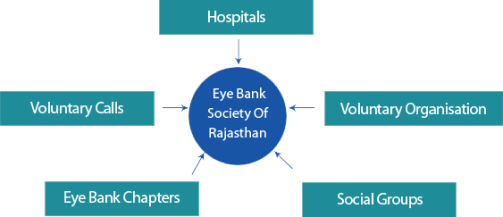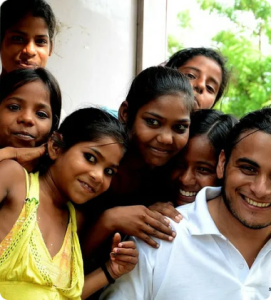Executive Committee
AWARENESSES ABOUT EYE DONATION
A large number of corneal blind people are needlessly blind because they are not able to get a cornea for transplant. The tragedy is that hundreds of corneas are wasted on reaching the Cremation ground due to lack of awareness that these corneas can give a new lease of life and hope to the needy. Thus, it is our endeavour to make everyone aware so that people from all walks of life understand this Social Commitment and positively respond to Eye Donation.
- Therefore throughout the year awareness activities are undertaken such as, contacting various social groups, schools, organizations and public at large.
- Towards this end every year awareness Fortnight is celebrated globally from 25 August to 8 September. In this fortnight major events are as under:
- Seeking blessings of the Almighty at Ganesh Temple followed by Awareness Programme .
- Awareness among Religious Groups and Social Groups Lecture cum Presentation followed by Interactive Session at Police Academy at Jaipur and various police stations.
- Awareness Programme at Ophthalmology Department and interactive session with Jurists of SMS Hospital Jaipur.
- Lecture cum Power Point Presentation at leading Colleges of Rajasthan.
- Press Conference discussions by experts in TV programmes, Radio Talks.
The closing ceremony of the Awareness Fortnight is held on 8th September every year by planting trees in the memory of eye donors in the ‘Netradan Smiriti Van’ created by JDA in the Central Park Jaipur. Besides the donors and the recipients senior dignitaries of Rajasthan Government actively participate in the event.

Lorem ipsum dolor sit amet, consectetur adipiscing elit.

Lorem ipsum dolor sit amet, consectetur adipiscing elit.
Procurment
Eye Bank Society of Rajasthan (EBSR) is harvesting corneas through two major sources.
Firstly, corneas are procured with the efforts of Member, Counselors and professionals through the process of HCRP, from major Hospitals of Rajasthan like SMS Hospital Jaipur and JLN Hospital Ajmer.
Secondly, through voluntary donation from community at large. As a result of intensive awareness efforts and continuous contact programme, over a long period of time, and involvement of many socially active groups and individuals good number of corneas are received through voluntary calls from families.

Processing
Collection of Cornea
Removal of cornea from a dead body is known as Enucleation. When an enucleation / donation call is received from the donor family by our counselor, following details are collected from the informant:
- Name, age, sex of the deceased person (donor)
- Cause & time of death Death
- Death occurred in the hospital or at home
- Home address and nearest landmark
- Informants name and phone number
A EBSR technician immediately starts to procure the cornea from the donor.
The cornea is enucleated by standard surgical procedures maintaining aseptic conditions during and after removal of the cornea from eyes. The eyelids are stitched using a black thread. This gives an appearance as if the donor is asleep. There is absolutely no disfigurement of the face after cornea is removed.
After the enucleation, the technician draws 5 ml of blood from the donor to screen for infectious diseases. The enucleated corneas are transported in a special glass bottle with a metal stand termed as Moist Chamber and transported to the Eye Bank for processing and utilisation immediately.

Lorem ipsum dolor sit amet, consectetur adipiscing elit.

Lorem ipsum dolor sit amet, consectetur adipiscing elit.
Serology Test :
The blood sample of the donor is put through serology test to check for HIV and Hepatitis B. Only if the serology result is negative, the donor cornea is used for excision.
Evaluation using Slit Lamp :
The cornea is evaluated under the slit lamp .It enables the ophthalmologist / eye bank technicians to study the layers of the cornea individually (Epithelium, Stroma & endothelium) to identity Corneal defects. The slit lamp view helps assess the qualitative strength of the endothelium (the inner layer of the cornea) and decide its utility for Penetrating Keratoplasty, therapeutic use, or for research and training purposes.
Cornea Evaluation under Specular Microscope: Cornea
Endothelium is the innermost layer of cornea and is primarily responsible for the quality of the vision after a cornea grafting surgery (PKP). The assessment of the endothelium becomes important to decide the utility of the tissue. The Specular microscopy allows direct high magnification of the endothelial cells and consequently better judgment of its status by counting the number of cells / mm square.
Endothelial cell analysis:
The endothelial cells of the donor cornea can be viewed under a Specular microscope to analyse :
- Cell density – ideally it should be > 2000 (PKP)
- o Hexagonality of the cells which should be more than 50%
Slit Lamp Evaluation:
After excising the cornea, it is superficially evaluated under the slit lamp for grading.
- Excellent
- Very Good
- Good
- Fair
- Not suitable for surgery
After passing through all these tests a tissue is certified as suitable for transplantation by the Medical Director of EBSR.

Lorem ipsum dolor sit amet, consectetur adipiscing elit.